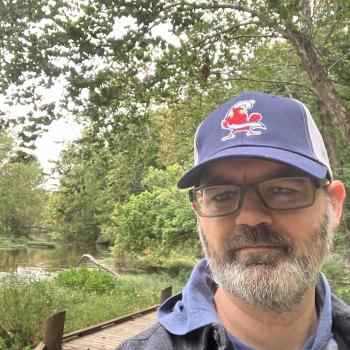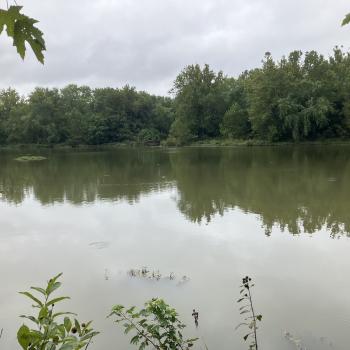This is the second part of a series on mystery and wonder. I would like to introduce it with an actual point from within the audio/video. I quote Kallistos Ware extensively. He’s a Metropolitan (like a Bishop) in the Greek Orthodox Church of Britain.
What I say about Kallistos Ware has to do with his voice, his booming English accent. If you compare him to C.S. Lewis, you might find that their voices sound similar, at least in my opinion. I mean no disrespect by it, but it makes me think about this topic.
VIDEO: Mystery & Wonder, pt. 2: Setting a fence around the mystery
i. One example of the mysteries of God being unexplainable is that He ministers through us, even though we have frailties, or things that stand out about our presentation and speech.
Consider Moses who, in our modern day language, has a speech impediment (Exodus 4.10). Consider Isaiah who goes for quite some time in his ministry with unclean lips, until God sanctifies his lips with a coal from the altar (Isaiah 6.5-7). Or think about Paul who refuses to preach with the wisdom of man, but relies more on what we would call his altar calls, his demonstration of the Spirit in power (1 Corinthians 2.1-5).
I just wonder if some of us would want Kallistos Ware, with an English accent, to preach in our pulpits. Would we want Moses with a speech impediment? Or would we want Isaiah, who is prophesying well before the coal touches his lips? Would we want him to speak in our pulpits? Would we want Paul who obviously pushes toward the prayer time and the demonstration of the miraculous?
Now just think about how God uses them.
Think about the signs and wonders that He does through Moses. Think about the amazing prophetic utterances that we have throughout the book of Isaiah. And think about the many miracles we see as Luke tracks Paul’s ministry through the book of Acts.
What can God do through us? It certainly is a mystery.
ii. Carl Jung declares, “We have stripped all things of their mystery and numinosity; nothing is holy any longer.”[1]
What a pronouncement upon our civilization, from someone who had an eagle-eye over our civilizations!
Jung uses the terms “mystery and numinosity” the way we use the terms mystery and wonder. The meaning of numinosity is fairly close.
The point is that we no longer live in a society that feels like we have a need for the supernatural. It’s a sad state of affairs in America and Western society today.
We don’t think we need mystery and wonder . . . don’t think we need spiritual values and meaning . . . or don’t need numinosity . . . but do we?
We must authentically connect with what the Spirit is doing among us. Unless we connect we can lose our footing as a true community of faith.
iii. Describing the Indescribable
We are only making an attempt. Nobody can put God in a box. How do we describe the indescribable?
Acts 3.9-10 (KJV): And all the people saw him walking and praising God: And they knew that it was he which sat for alms at the Beautiful gate of the temple: and they were filled with wonder and amazement at that which had happened unto him.
We’re looking a two Theological terms that are similar to wonder and amazement. One is mystery and the other is wonder.
Metropolitan Kallistos Ware explains this thoroughly, so we’ll rely on his definitions as we explore these concepts.
iv. Mystery
Kallistos Ware says:
“A mystery, theologically understood, is not just an unsolved problem, a baffling conundrum. A mystery is something that is revealed to our understanding, but it’s never exhaustively revealed because it reaches out into the infinity of God . . . How can God be simultaneously both one and three? How can Christ be fully and completely God, fully and completely man? In the end, we cannot explain . . .
Our theological statements set a fence around the mystery, but they don’t exhaustively describe it.”[2]
 Greg O’Beirne, Typical Western Australian jarrah picket fence (circa 1930’s) with overhanging strelitzia, Mount Lawley, Australia, 10.24.02
Greg O’Beirne, Typical Western Australian jarrah picket fence (circa 1930’s) with overhanging strelitzia, Mount Lawley, Australia, 10.24.02
Mystery is a way to describe the indescribable glory of God, or God’s activities. So we’re attempting to explain what God is doing among us.
It’s important to note that we can’t figure God out completely. For example, there are things that He does at our altars and in our services, that we can’t explain to those who weren’t with us in our worship service. We can try to share some examples of what happened, but we can’t recreate the experience. When God’s presence is with us, when God is moving among us, we can’t figure it out completely.
Kallistos Ware says, “In the end, we cannot explain . . . Our theological statements set a fence around the mystery, but they don’t exhaustively describe it.”
We “set a fence.”
We approach an understanding of God, but we never master our understanding of God.
[1] Carl G. Jung, Man and His Symbols (Garden City, NY: Doubleday & Company, 1969), 94. [2] Kallistos Ware, “How Should We Study Theology,” Seattle Pacific University Palmer Lectures in Theology, iTunes/iTunesU, March 17, 2008.













